by Julia Mazal // Nov. 28, 2022
This article is part of our artist Spotlight Series.
Working with illusion, the appearance of motion, and the fragility of material, German-Luxembourgish artist Vera Kox seeks to challenge many preconceived notions of sculpture. A student of fine arts who started with painting, but eventually feeling restricted by the limits of the canvas, Kox began her exploration of an array of materials through installation and sculpture. However, one could say that the term “sculpture” is also a semantic constriction on Kox’s practice. While technically static, her work always seems to be moving. Through craftful manipulation and careful presentation, the artist’s sculptures and installations represent the fluidity and process of transformation undergone by the very materials she molds.
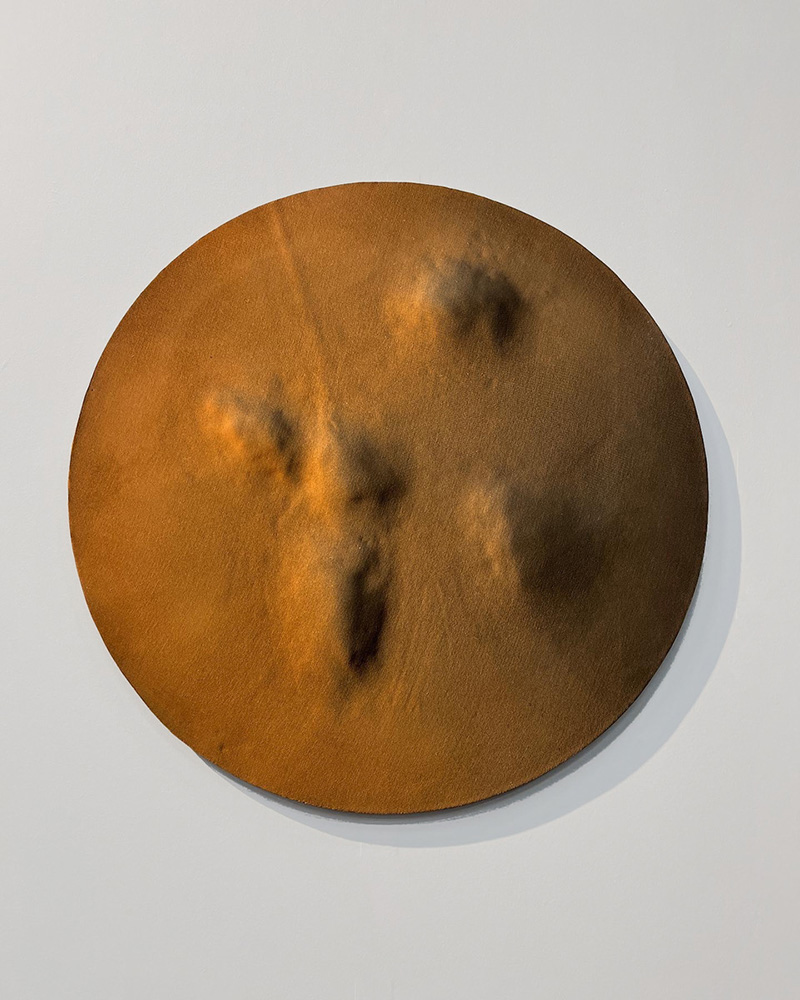
Vera Kox: ‘Soft as a Rock,’ 2022, diameter 67cm, d 5 cm // Courtesy of the Artist and VG Bild-Kunst, Bonn 2022
Her new series, ‘Soft as a Rock’ (2022), also the title of her recent show at Nosbaum Reding Projects, Luxembourg, consists of sphere-like wall-based works. The initial encounter with the new pieces is quite deceiving. You find yourself squinting and moving back and forth to understand the plane on which the pieces exist. From afar, each resembles a deserted planet with bumps and bulges, but once faced with the work up close, a fine, fabric-like texture materializes, adding another visual layer to the illusion. The way the light hits the shimmer of the underglaze changes the color. A piece that at first appears jet black can suddenly gain a blue hue. The uncertainty of whether the surface is flat becomes part of the dialogue the viewer enters into. When standing directly in front of the piece, the textured surface looks like a mere shadowing effect, but as you move to the side, it becomes three-dimensional. This speaks to the artist’s recurrent theme of illusion: is it liquid or solid, soft or hard, smooth or textured?
The artist draws on concepts such as the Symbiocene, a period of re-integration of humanity into nature, both in her conceptual approach and in her use of material. This concept shifts away from the current anthropocentric narrative to envision a relationship between humans and nature that is symbiotic, mutually beneficial and interconnected. This, in turn, shines through in the different materials she uses and pairs together. For example, in a recent site-specific installation at the Kunstverein Reutlingen titled ‘…. into deliquescence’ (2021-2022), (which means the process of becoming or having the tendency to become liquid), Kox presents pieces of layered, collapsed ceramic, placed on top of rubber mats or insulation panels. The contrastings materials of ceramic, which is formed from clay that bears the results of centuries of sedimentation, and rubber, which brings with it associations of man-made, industrially manufactured objects, come together to form a whole through her minimalist language and expression. With some of the ceramics, she has combined hand-blown glass and streams of aluminum that have solidified into thin lines trailing down their sides. Looming over these combinations of materials are steel rod constructions that appear to be weighed down by hanging pieces of hair at the ends, bringing the human/animal element into the equation.
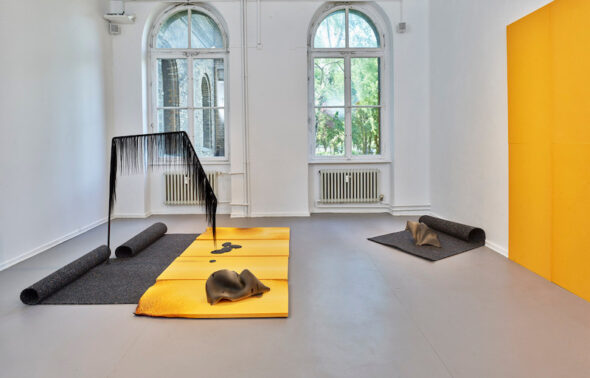
Vera Kox: glazed ceramic, glass, insulation foam, rubber, hair extensions, steel installation view in ‘…into deliquescence, 2022’ // Photo by Eric Tschernow
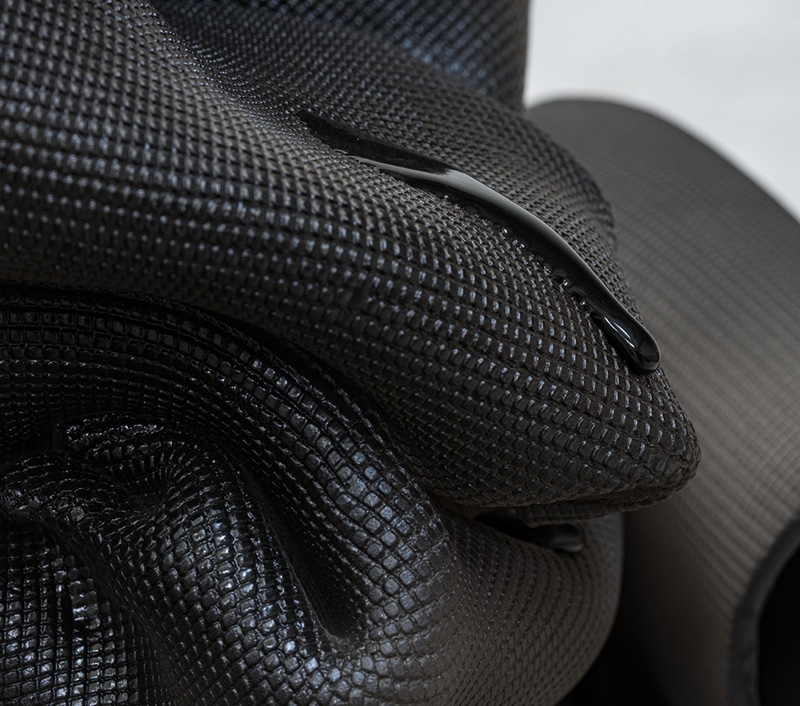
Vera Kox: ‘((undulating)),’ 2022, glazed ceramic, glass, insulation foam, ceramic, 70x117x77cm // Photo by Andreas Baudisch
Treating the pieces not as sculptures but rather as creatures or organisms is also a constant in Kox’s work. In a new series ‘….into the peripheral, reflecting’ (2022), which was presented in a group exhibition ‘Nothing is Permanent’ (2022) in Esch/Alzette, Luxembourg, Kox takes her ceramics out of the studio and into the grasslands. The series consists of two primary elements: three pinkish ceramic creatures and the yellow steel beam supporting one of them. The resulting outdoor installation becomes a story with snapshots of different moments in time — nature in its untouched state, the industrial beam as a remnant of a past industrial city, and the pink creature, which could be an organism that has outlived humanity. This creature has two other siblings living in the water, one on the banks of the stream and the other embedded into the marshes.
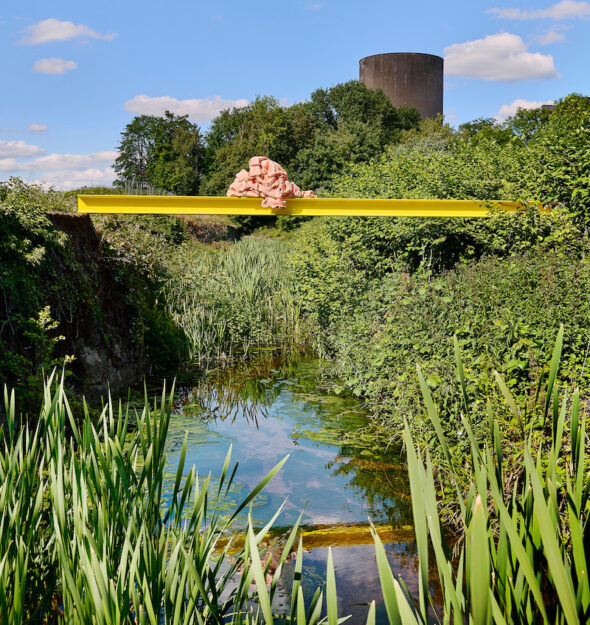
Vera Kox: ‘…into the peripheral, reflecting,’ 2022, glazed ceramic 97x160x67 cm, painted steel beam 900 cm, installed in Esch/Alzette, LU as part of Esch 2022 // Photo by Lukas Roth
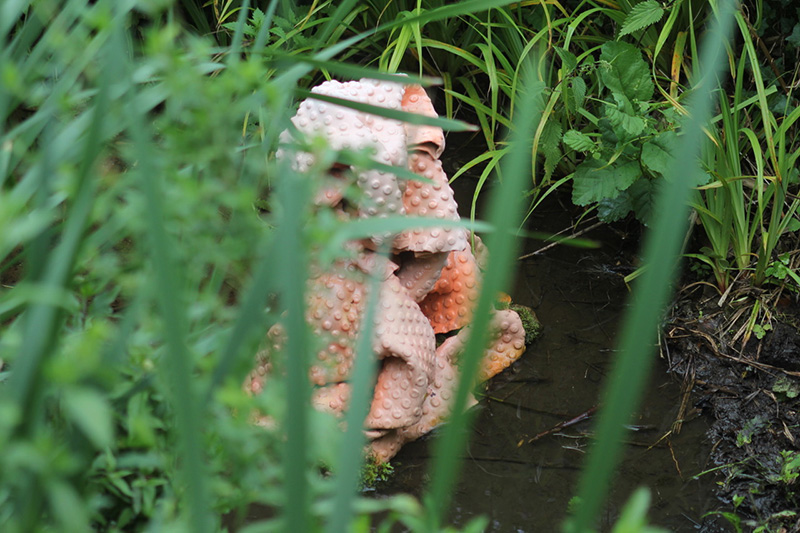
Vera Kox: ‘…into the peripheral, reflecting,’ 2022, glazed ceramic 97 x 160 x 67 cm, painted steel beam 900 cm, installed in Esch/Alzette, LU as part of Esch 2022 // Courtesy of the Artist
For Kox, the exchange with the viewer begins as soon as they enter the space. Her work is in constant metamorphosis capturing the state of change of each material. As the aluminum hardens, or the ceramic is fired in the kiln, it’s the process of hardening from liquid to solid that Kox is able to depict. In contrast to conventional notions of sculpture — masculine, static, and strong — her work explores fragility. The materials evoke a sort of tension, the final shape dictated by their tipping point, the edge of a crack, tear or collapse, which brings to mind the critical thresholds in our ecosystems that if crossed could cause irreversible damage to the climate. Yet through her installations, Kox manages to create a unity in materials that otherwise exist in stark contrast to each other so as to conjure symbiotic possibilities and new formal relationships.





















